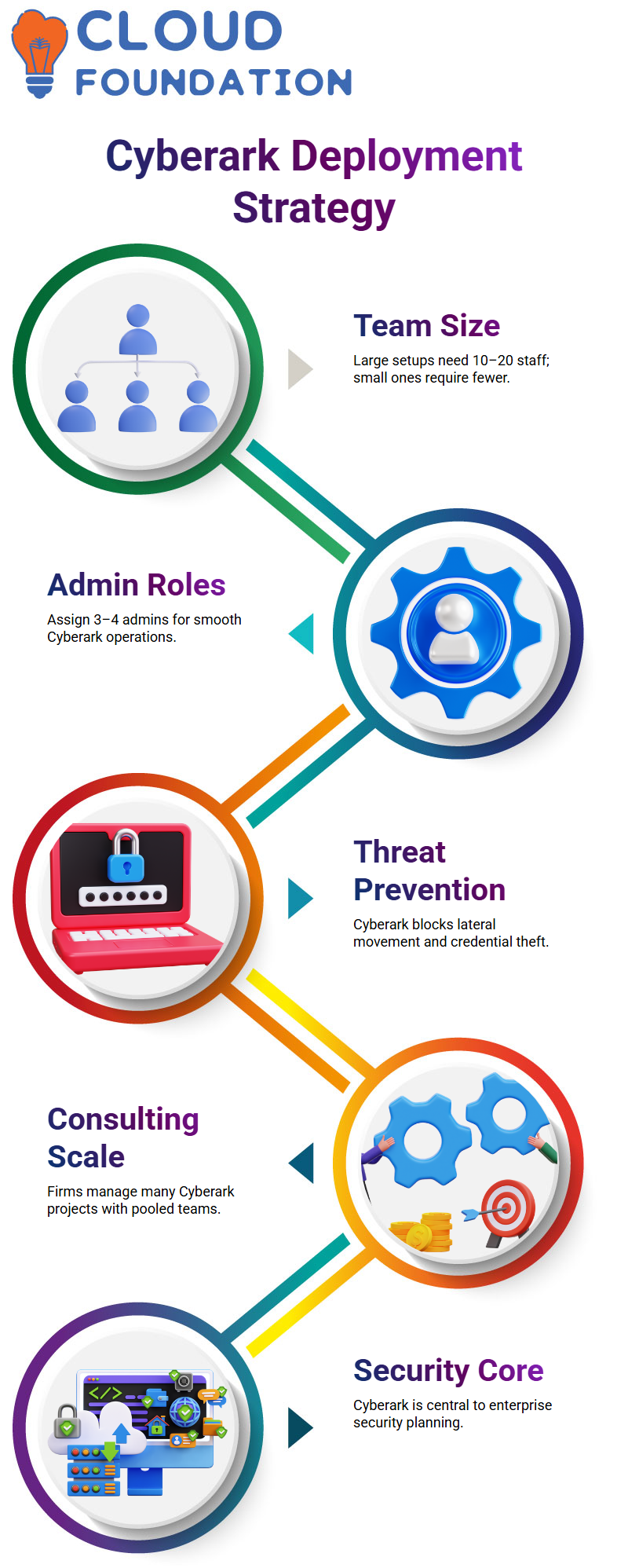Cyberark Privileged Access Management Training
Cyberark PAM and Secure Session Management
One thing that caught my attention when I initially began looking at Cyberark was how it makes sure that no illegal activity interferes with ongoing work.
Cyberark maintains control even if a hacker manages to get credentials. For instance, if someone is currently completing a work within Cyberark, no one else may disturb that activity.
This indicates that Cyberark maintains systems’ stability and security even under the most dire circumstances.
Key Features of CyberArk PAM
CyberArk finds every privileged account in your company and keeps an eye on them all the time. It isolates sessions for these accounts so no one may interfere with them.
CyberArk makes sure users only have access to the information they need to complete their duties by enforcing least privilege everywhere.
By effectively managing credentials, CyberArk stops unwanted access. It offers centralized administration, session separation, and proactive detection.

You can safeguard critical data in on-premises, cloud, and hybrid systems with CyberArk. By serving as the primary center for privileged access security, CyberArk keeps your company secure from both internal and external attacks.
CyberArk vs Other PAM Solutions
CyberArk is still a leader in the PAM area, despite the presence of several products such as BeyondTrust, OnCloud, Identity4, and Delinea. To stop tampering, CyberArk isolates sessions, controls credentials, and finds privileged accounts.
CyberArk is the best in terms of features and dependability, even if products like Okta have PAM capability.The fundamentals of other PAM solutions are simpler to comprehend after you have a firm understanding of CyberArk. CyberArk sets the benchmark, yet the fundamental idea is still the same.
It detects all privileged accounts throughout an enterprise, maintains their credentials, and ensures sessions are safe. The tools offered by CyberArk make managing security for both internal and external threats easier.
Cyberark Privileged Access Rules
I take away an employee’s privileged access to Cyberark seven days prior to their departure when they provide notice. To prevent anybody from executing risky commands without permission, I established rules in Cyberark.
In order to prevent workers from circumventing security measures, I set up Cyberark to need management clearance for sensitive tasks.
Cyberark keeps track of any attempts to abuse access before departing and guards against system corruption.Cyberark is the enforcement point for me; it enforces the automations I create and blocks instructions that can destroy PAM components.
Cyberark Roles and Teams
To keep duties clear, we must outline roles around Cyberark. Working with a Cyberark account manager who manages licenses and vendor connections is necessary. The L3 and L4 teams then concentrate on the development and deployment of Cyberark.
Cyberark troubleshooting and regular exercises are managed by L2 administrators. They seek advice from the L3/L4 Cyberark implementation team if they are unable to resolve a problem.
Cyberark Operations and Onboarding
The L1 operations team primarily oversees the daily management of privileged accounts in Cyberark. I ensure that accounts are onboarded, connections are checked, and password rotation rules in Cyberark operate as planned.
I utilize Cyberark logs to troubleshoot onboarding and rotation errors since they appear rapidly. Cyberark protects privileged credentials while providing users with dependable access.
Cyberark Implementation and Support Levels
Cyberark is estimated to need 10–20 operations people in bigger businesses, whereas smaller installations require fewer. I have seen consultancy businesses using whole teams to oversee Cyberark for several customers.
We must designate two to three individuals for implementation work and a minimum of three to four administrators for Cyberark on regular projects.
This personnel makes issue reaction times quick and aids in Cyberark’s growth.

CyberArk Training

Cyberark Protecting Against Internal Threats
A well-executed Cyberark implementation limits vertical and lateral movement and guards against credential theft. I set up Cyberark to prevent attempts to access admin or automation accounts and to restrict privilege escalation.
Cyberark monitoring and restrictions make it considerably more difficult for an inside attacker to move laterally.
I depend on Cyberark to prevent misuse and protect private customer information.
Cyberark Scale and Consulting
I’ve collaborated with consulting businesses who manage hundreds of projects for Cyberark; they pool resources to service a large clientele. I’ve done personnel calculations and seen Cyberark teams expand rapidly in response to increased demand.

Businesses invest in personnel and procedures around Cyberark because it manages essential PAM operations. I always consider Cyberark to be at the heart of the security model and create processes that take it into account.
CyberArk and Protecting Privileged Access
CyberArk is essential when discussing the security of corporate data. Let me tell you how. External attackers often employ spam or phishing emails to attempt to get user credentials.
They may fool someone into disclosing a password, but CyberArk thwarts their plans right away. CyberArk makes sure that credentials are never given to the end user directly, even in the event that someone from outside the company tries to get access. By doing this, the assault chain is broken before it ever begins.
Additionally, internal risks are well handled. CyberArk stops employees from trying to elevate privileges and get access to systems they shouldn’t. CyberArk enforces least privilege, which means users only have access necessary for their daily work, regardless of whether the attacker is internal or external.

An IT analyst, for instance, has access to some resources but not to the VP of Finance’s account or human resources data. CyberArk guarantees strict control over crucial access.
CyberArk Stops Insider Threats
Attackers may try to abuse their access inside the company. CyberArk keeps an eye on and limits this kind of behavior. Unauthorized system login attempts are prevented. Only what they are intended to utilize is accessible to users.
The PAM and IAM features of CyberArk are based on the least privilege concept. It guarantees that internal threats cannot migrate laterally across systems or escalate privileges.
CyberArk takes a proactive approach. It prevents tampering, separates sessions, and identifies questionable activities. CyberArk stops insiders from using their privileged credentials maliciously. Internal security is thus just as robust as perimeter security.
CyberArk in a Broader Security Landscape
CyberArk doesn’t function alone. It safeguards privileged accounts on important infrastructure, databases, apps, and endpoints. CyberArk guarantees the security of credentials for anything from nuclear power plants to industrial control systems.
Even very sensitive data, like databases belonging to the military or the government, is shielded from unwanted access. CyberArk also protects financial systems, social media accounts, and network devices. Every employee who need access communicates with CyberArk, guaranteeing that the appropriate individuals have access without disclosing passwords.
CyberArk protects access in the background, whether it’s in a financial setting, fast food restaurant, or television network.
Cyberark Recording and Auditing of Privileged Sessions
All actions carried out inside Cyberark using privileged accounts are automatically documented and recorded. This function is very beneficial to me as it gives me insight into what goes on behind the scenes. Cyberark’s monitoring engine is able to identify any suspicious behavior in real time and take prompt action.
For instance, Cyberark immediately suspends a user’s session if they try to remove a database or alter sensitive data. Restarting access is only possible by the Cyberark administrator or operations team. Because of this proactive monitoring, bad orders are detected before they have a chance to do any damage.
Cyberark Remediation and Risk Response
Cyberark not only detects dangerous conduct but also immediately fixes it. Imagine someone attempting to remove a whole database. Cyberark notifies the PAM team and instantly ends the session. This automatic reaction shields the infrastructure from unwanted alterations and averts possible harm.

CyberArk Online Training

Cyberark Credential Discovery and Management
There are hundreds of accounts in every firm, including developers, administrators, and Oracle users. They all have passwords, and it’s crucial to handle them safely. These accounts are automatically found and onboarded by Cyberark. The passwords are automatically rotated and kept safely once they are within Cyberark.
I like how Cyberark maintains the password complexity guidelines, which include using special characters, avoiding basic or repeating patterns, and requiring a minimum of eight characters.
Passwords may be changed right away after onboarding to make sure that not even the Cyberark administrator is aware of the credentials. Everything in Cyberark’s vault operates automatically.
Cyberark Vault and Secure Storage
Cyberark stores all credentials in the Vault, a very secure part. Think of it as a digital safe that safeguards all privileged credentials and passwords. Even if you are the administrator of Cyberark, you can only read encrypted passwords.
The fact that only Cyberark can decode them ensures the highest level o security. This technique protects credentials from both internal and external attacks. The Vault’s design makes sure that no one, not even empowered administrators, may abuse stored credentials.
Cyberark Session Isolation and Proxy Access
The fact that Cyberark separates credentials and sessions is among the most intriguing things I’ve discovered about it. Cyberark serves as a proxy when a user connects to a target system. The connection initially passes via Cyberark’s proxy component before reaching the Unix or Windows server directly.

This guarantees that there is no direct disclosure of credentials. It’s similar like choosing a new route to work each day so that nobody can guess where you’re going. The task is completed safely and effectively even when the user is unaware of the precise path Cyberark uses to connect.
Cyberark Session Recording and Activity Monitoring
Inside Cyberark, every session is videotaped. Everything is recorded and accessible at a later time, including the creation of tables and the execution of scripts. Administrators may examine a thorough audit trail created by this recording capability.
For instance, Cyberark immediately detects any efforts to alter databases or remove the vault. Because they are aware that their activities are being monitored, users are deterred from engaging in dangerous activity. It strengthens Cyberark’s security posture and is a potent accountability tool.
Cyberark Privileged Account Monitoring
Cyberark closely monitors activities related to privileged accounts. The session is detected if someone attempts to examine passwords or access accounts that are prohibited. The technology displays real-time risk ratings and flags such activity in red. Administrators may then choose whether to end the session or suspend it.
Cyberark has a significant edge in preserving operational security because to this realtime control. I’ve seen how Cyberark gives businesses the assurance that their most sensitive assets are protected by making privileged access visible and controllable.
Cyberark Risk Detection and Automated Response
Cyberark doesn’t only notify you when it notices questionable activity; it takes action. In order to avoid further damage, the session is promptly ended. For example, Cyberark disconnects the connection before any harm is done if a user tries to remove data or access credentials that are prohibited.
One of the main reasons I like Cyberark so much is its real-time remedial tool. It creates a safe environment for privileged access management by fusing automation, security, and intelligence.
Cyberark Key Features in Practice
Working with Cyberark has allowed me to see how its main functions—session recording, vault storage, credential rotation, and risk remediation—all operate together. Cyberark streamlines the difficult task of protecting privileged accounts without sacrificing effectiveness.
Cyberark’s multi-layered security may help any firm that manages critical technology. Cyberark makes sure that no security hole is left unattended, whether it be via automated credential management, password isolation, or session monitoring.

Navya Chandrika
Author
